SEO
Are Outbound Links A Google Search Ranking Factor?
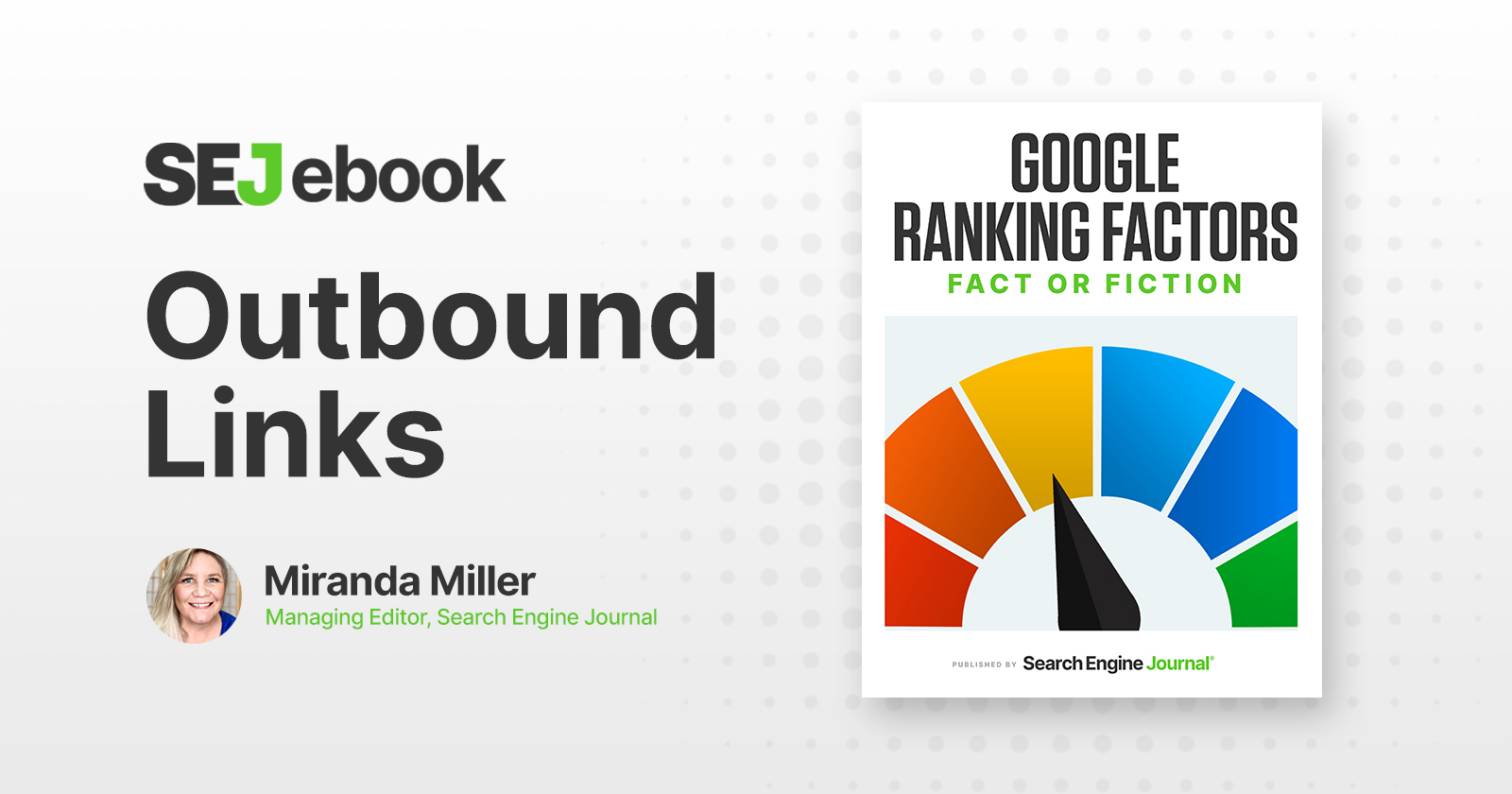
You can’t throw a stone in SEO without hitting a link builder.
Since Google’s earliest days, links are – and have always been – an integral part of search optimization.
But what about outbound links?
These are the links in your content (the source) that point to a different website (the target).
But are outbound links actually a ranking factor?
The Claim: Outbound Links As A Ranking Factor
Google sees links from one site to another as a sort of endorsement.
When one site cites another via a link, there’s a fairly good possibility that they’re doing so because they believe the content they’re linking to is reputable, authoritative, and trustworthy.
Is that always the case? No.
As long as there have been search engines and links, marketers have been trying to find ways to manipulate Google’s perception of what a link actually means.
We know that when a site links to you, it can help improve your search rankings.
Advertisement
Continue Reading Below
But what about when you link to another website – can that help your site rank higher, too?
The SEO industry has never entirely come to a consensus on whether outbound links are a direct ranking factor in Google’s algorithm.
Many believe outbound links aren’t a ranking factor at all and have no SEO benefit to the linking party (the source).
However, some believe that who you link to is a signal that can help your own rankings, as well as the page that earned your link.
The Evidence For Outbound Links As A Ranking Factor
Google’s John Mueller addressed that very question in the inaugural Ask Google Webmasters video in July 2019. He said:
“Linking to other websites is a great way to provide value to your users. Oftentimes, links help users to find out more, to check out your sources, and to better understand how your content is relevant to the questions that they have.”
In the same video, Mueller cautions that the reasoning behind the link matters – and Google is pretty good at sniffing out bad links.
Advertisement
Continue Reading Below
He calls out reciprocal links, paid links, and user-generated comments as types of links that Google may see as of dubious quality. For these links, you should be using rel=”nofollow.”
See Julie Joyce’s guide, When to Use Nofollow on Links & When Not To, for more on that.
In short, Google wants to see outbound links that indicate you think the page you’re linking to is a great match for users.
So, we know that user experience and the value provided to searchers/site visitors is Google’s top priority.
As Mueller said, outbound links are a great way to provide value to users.
Plus, we have a bunch of other SEO pros and blogs saying things like:
- “…valuable outbound authority links are part of what Google likes to see as part of its recent Google Panda update.”
- “By adhering to some of the following best practices when optimizing outbound links – you could be seeing an effect on your visibility and ranking.”
Some even quantify what you need to do for outbound links to “work” and recommend including at least two or three per piece of content.
(I’m not linking to those sources as I don’t want to lend them our credibility. See how that works? Suggesting in 2021 that a certain density of outbound links is SEO magic makes about as much sense as optimizing for a keyword density of 7%.)
Aside from the industry chatter, Shai Aharony at Reboot did a small experiment in 2016 in which his team created 10 brand new sites with articles “of comparable structures and text length” to test whether outbound links influenced ranking.
The study got a bit of attention following an endorsement from Rand Fishkin, who said,
“This study of outgoing links impacting rankings is as close to ‘proof’ as we get in the SEO world…”
Half the sites contained three links – one each to Oxford University, Cambridge University, and the Genome Research Institute. Two used the name of the institution as anchor text; the anchor text for the third was the completely made-up test subject word “phylandocic.”
Another made-up control word, “ancludixis,” was placed in the content unlinked so they could determine whether the anchor text was a factor in ranking. All domains were purchased at the same time, and none were optimized for “phylandocic.”
Advertisement
Continue Reading Below
The study declares:
“The results are clear. Outgoing relevant links to authoritative sites are considered in the algorithms and do have a positive impact on rankings.”
The analysis goes on to say:
“The main thing to take away from this test is that although we don’t know and have not proved how powerful outgoing links are in the grand scheme of things, we have proved they do have a positive impact if used correctly.”
However, this evidence is not exactly convincing.
Here’s what we see in the results. The author notes that the graph shows the position of the sites in the ranking.
- Blue line = site with an outgoing link.
- Orange line = site without outgoing links.
As you can see, the sites with the outbound links ranked in the top five Google results and those without in the next five.
Advertisement
Continue Reading Below
Without seeing the content itself, it’s impossible to know whether there are other factors at work.
But we do know that the made-up target keyword, “phylandocic” was used as anchor text once in at least each article. Did it increase rankings because it was anchor text, or simply because the word appeared on the page?
This test is simply too small. The fact that there’s no other content in Google’s index about this made-up word pretty much ensures you’re going to get the top 10 results with 10 articles.
All other things being equal – and it does seem they took steps to make all other things as equal as possible – this could just be a matter of the additional keyword mention making those articles more relevant to the query.
So does this actually prove anything about the value of outbound links as a direct ranking signal? No.
The Evidence Against Outbound Links As A Ranking Factor
Outbound links can tell Google a lot of positive things about the site the link is pointing to – that it’s considered authoritative and trustworthy, for example.
Advertisement
Continue Reading Below
Or that the person who created the content is an expert in the field.
That’s exactly what Google wants to see in the content it recommends as answers to searchers, and they tell us that throughout Google’s Search Quality Raters guidelines.
Get your free SEJ Guide to Google E-A-T & SEO to learn more about that.
But Google also has to consider that there are a lot of ways links can be manipulated. They’re a commodity that can be bought and sold.
People can exchange links for other links or for anything of value to the parties involved – for a free product or discount on services, for example.
Links can even be placed on a website without the owner/webmaster’s knowledge via code or URL injection.
There are a lot of different ways links can be gamed. Outbound links, in particular, are troublesome as a search signal.
Couldn’t I just link to a bunch of highly authoritative, popular sites in my niche and that tells Google I’m one of the cool kids, too?
Advertisement
Continue Reading Below
At one point, you could. This PageRank sculpting blog post by Matt Cutts resurfaced in a 2019 Twitter conversation about the benefit of linking to authoritative content.
A user asked Mueller whether the conclusion made in a graphic that cited “multiple SEO experiments and studies” was true.
Despite the fine print making it clear that the studies found correlation and not causation, the piece made a bold statement. And Mueller was clear in his response:
No
— 🐄 John 🐄 (@JohnMu) December 29, 2019
Here’s where the aforementioned PageRank sculpting post comes in:
Hey @JohnMu, in Matt Cutts’ tenure, he told us repeatedly that outbound links were beneficial. For example, in this blog post (https://t.co/hx6I5LhLaD), he states: “parts of our system encourage links to good sites.”. Can you help reconcile the contradiction?
— Corey Northcutt (@corey_northcutt) December 30, 2019
Advertisement
Continue Reading Below
But here’s the thing – that Cutts post is from 2009.
Search is constantly evolving. It’s not a “contradiction” that the advice from that time would be different a decade later.
The issue came up in 2015 when Mueller responded to a Webmaster Central viewer question about any potential benefits of linking to one’s trade association websites:
“We would say there’s not any SEO advantage of linking to anyone else’s site.”
And again in a 2016 video where Mueller was asked:
“External links from your pages to other sites – is that a ranking factor? What if they’re nofollow?”
He responded:
“From our point of view, external links to other sites – so links from your site to other people’s sites – isn’t specifically a ranking factor.
But it can bring value to your content and, in turn, can be relevant for us in search. Whether or not they’re nofollow doesn’t really matter to us.”
Google Search Liaison Danny Sullivan echoed this advice, that the value of outbound links is for users. This was in a series of 2019 tweets, one of which advised that SEO professionals should think of them in terms of journalistic integrity:
Advertisement
Continue Reading Below
I’d think of linking as just part of proper attribution. You’re a journalist. You write a story, you cite your sources. If those sources are online with more info for the reader, that cite should link to them. That’s just good journalism. It should be standard….
— Danny Sullivan (@dannysullivan) October 16, 2019
And this is where outbound links really shine.
Used appropriately, outbound links can tell Google things like:
- You’re aware of which people and websites in your industry are considered authoritative and trustworthy because you’re an active member of the community.
- You’ve done your homework and invested time in truly understanding the topic.
- You value multiple perspectives and are doing your best to present fair, balanced information to readers.
- You care about accuracy and it’s important to you that the information you reshare has been fact-checked.
- You value readers’ trust and want to ensure they can verify your statements if they choose.
These are all quality indicators that can help Google understand how accurate, relevant, and authoritative that piece of content is.
But are the links themselves a ranking signal?
Outbound Links as a Ranking Factor: Our Verdict

Here’s what we know:
- The presence of outbound links, or lack thereof, on its own is not a ranking factor.
- The words in outbound link anchor text are used to help Google understand the source page’s content – just like every other word on the page. They are no more or less valuable.
- Linking to high authority sites is not an indicator of the source page’s authority because it’s just too easy to game.
Your best strategy is to use outbound links in the way Google intends them to be used – to cite sources, to improve user experience, and as endorsements of high-quality content.
Advertisement
Continue Reading Below
Trying to use them to whisper at Google about your authority or relevance could backfire.
Overusing outbound links looks spammy in the same way overusing any other optimization looks spammy, and it could lead Google to ignore the page entirely.
Outbound links may have been a ranking signal in the early 2000s. However, Google has so many more reliable, less noisy signals to consider today.
Featured Image: Paolo Bobita/Search Engine Journal
SEO
Measuring Content Impact Across The Customer Journey
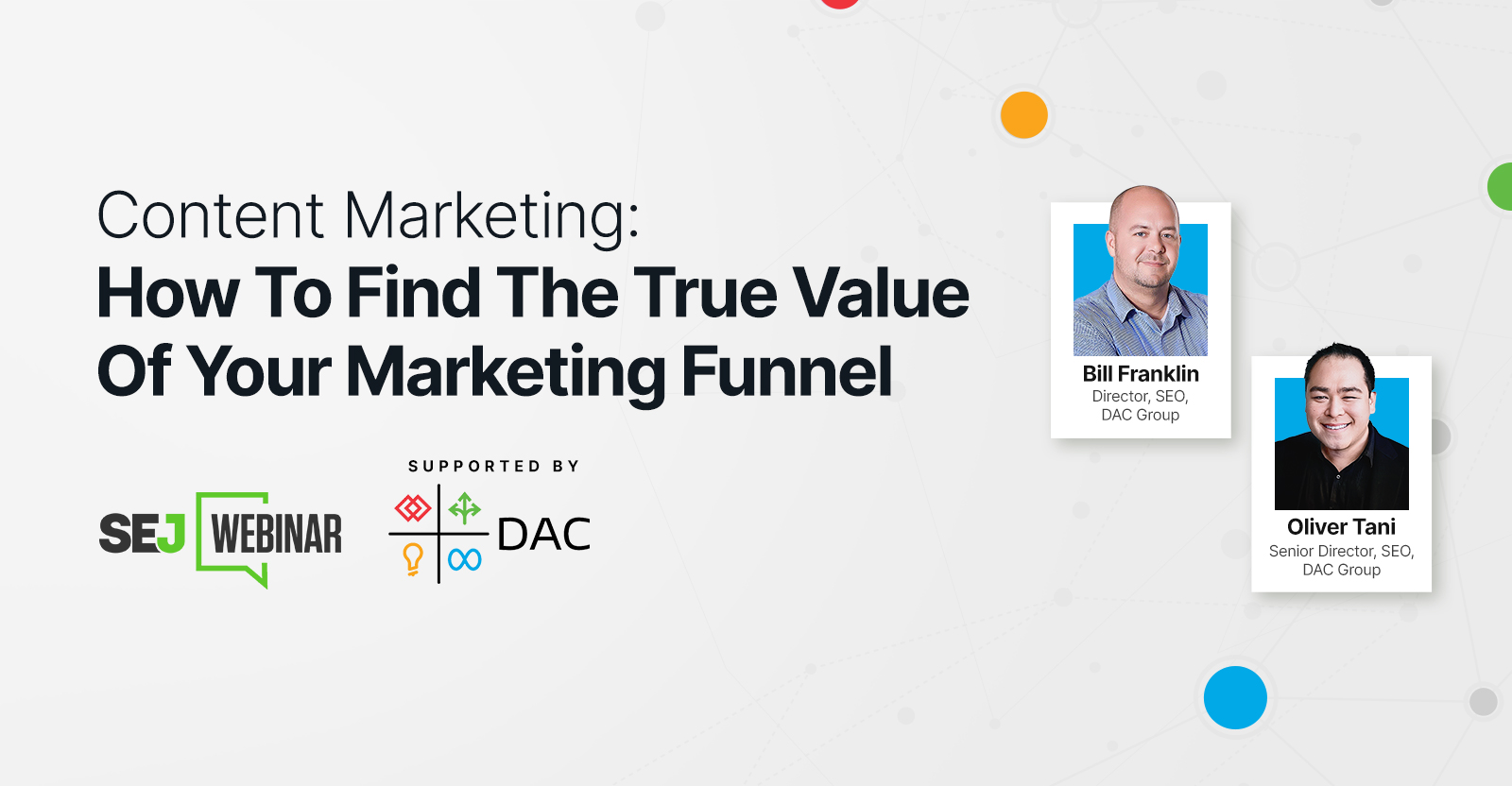
Understanding the impact of your content at every touchpoint of the customer journey is essential – but that’s easier said than done. From attracting potential leads to nurturing them into loyal customers, there are many touchpoints to look into.
So how do you identify and take advantage of these opportunities for growth?
Watch this on-demand webinar and learn a comprehensive approach for measuring the value of your content initiatives, so you can optimize resource allocation for maximum impact.
You’ll learn:
- Fresh methods for measuring your content’s impact.
- Fascinating insights using first-touch attribution, and how it differs from the usual last-touch perspective.
- Ways to persuade decision-makers to invest in more content by showcasing its value convincingly.
With Bill Franklin and Oliver Tani of DAC Group, we unravel the nuances of attribution modeling, emphasizing the significance of layering first-touch and last-touch attribution within your measurement strategy.
Check out these insights to help you craft compelling content tailored to each stage, using an approach rooted in first-hand experience to ensure your content resonates.
Whether you’re a seasoned marketer or new to content measurement, this webinar promises valuable insights and actionable tactics to elevate your SEO game and optimize your content initiatives for success.
View the slides below or check out the full webinar for all the details.
SEO
How to Find and Use Competitor Keywords

Competitor keywords are the keywords your rivals rank for in Google’s search results. They may rank organically or pay for Google Ads to rank in the paid results.
Knowing your competitors’ keywords is the easiest form of keyword research. If your competitors rank for or target particular keywords, it might be worth it for you to target them, too.
There is no way to see your competitors’ keywords without a tool like Ahrefs, which has a database of keywords and the sites that rank for them. As far as we know, Ahrefs has the biggest database of these keywords.
How to find all the keywords your competitor ranks for
- Go to Ahrefs’ Site Explorer
- Enter your competitor’s domain
- Go to the Organic keywords report
The report is sorted by traffic to show you the keywords sending your competitor the most visits. For example, Mailchimp gets most of its organic traffic from the keyword “mailchimp.”


Since you’re unlikely to rank for your competitor’s brand, you might want to exclude branded keywords from the report. You can do this by adding a Keyword > Doesn’t contain filter. In this example, we’ll filter out keywords containing “mailchimp” or any potential misspellings:
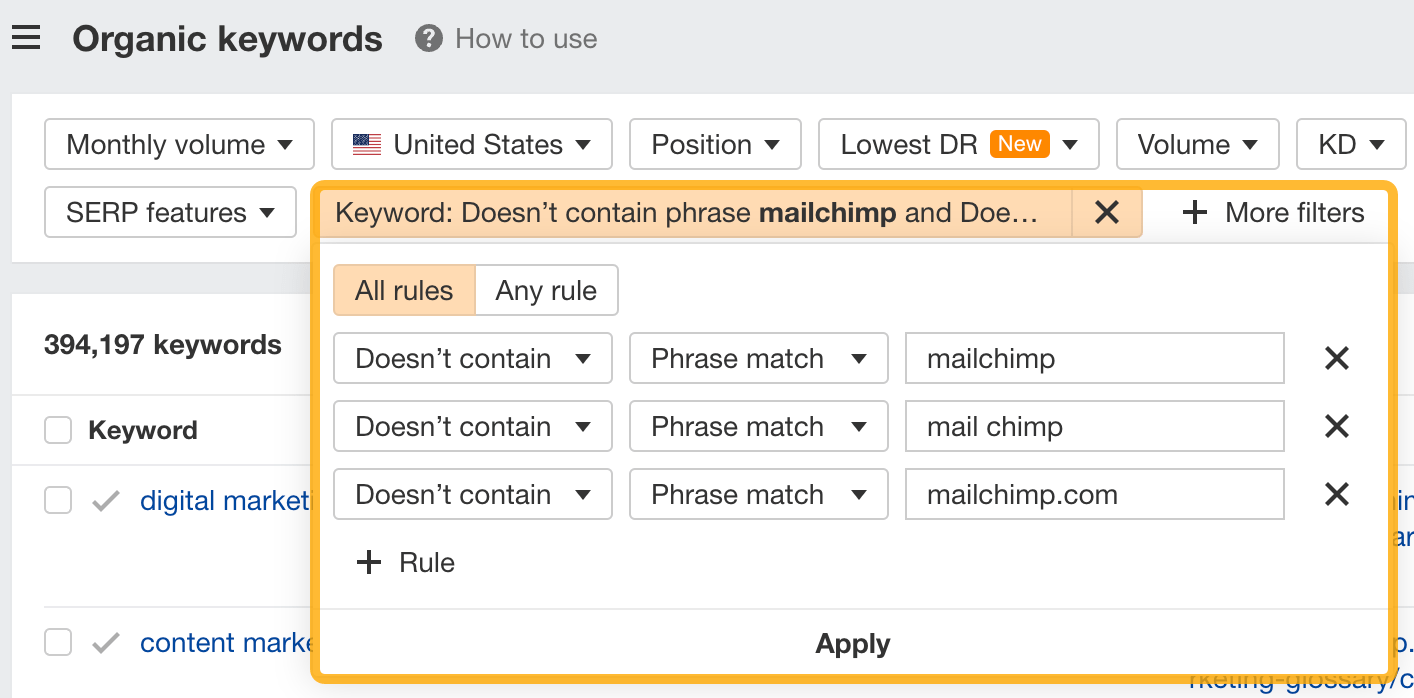

If you’re a new brand competing with one that’s established, you might also want to look for popular low-difficulty keywords. You can do this by setting the Volume filter to a minimum of 500 and the KD filter to a maximum of 10.


How to find keywords your competitor ranks for, but you don’t
- Go to Competitive Analysis
- Enter your domain in the This target doesn’t rank for section
- Enter your competitor’s domain in the But these competitors do section


Hit “Show keyword opportunities,” and you’ll see all the keywords your competitor ranks for, but you don’t.


You can also add a Volume and KD filter to find popular, low-difficulty keywords in this report.


How to find keywords multiple competitors rank for, but you don’t
- Go to Competitive Analysis
- Enter your domain in the This target doesn’t rank for section
- Enter the domains of multiple competitors in the But these competitors do section
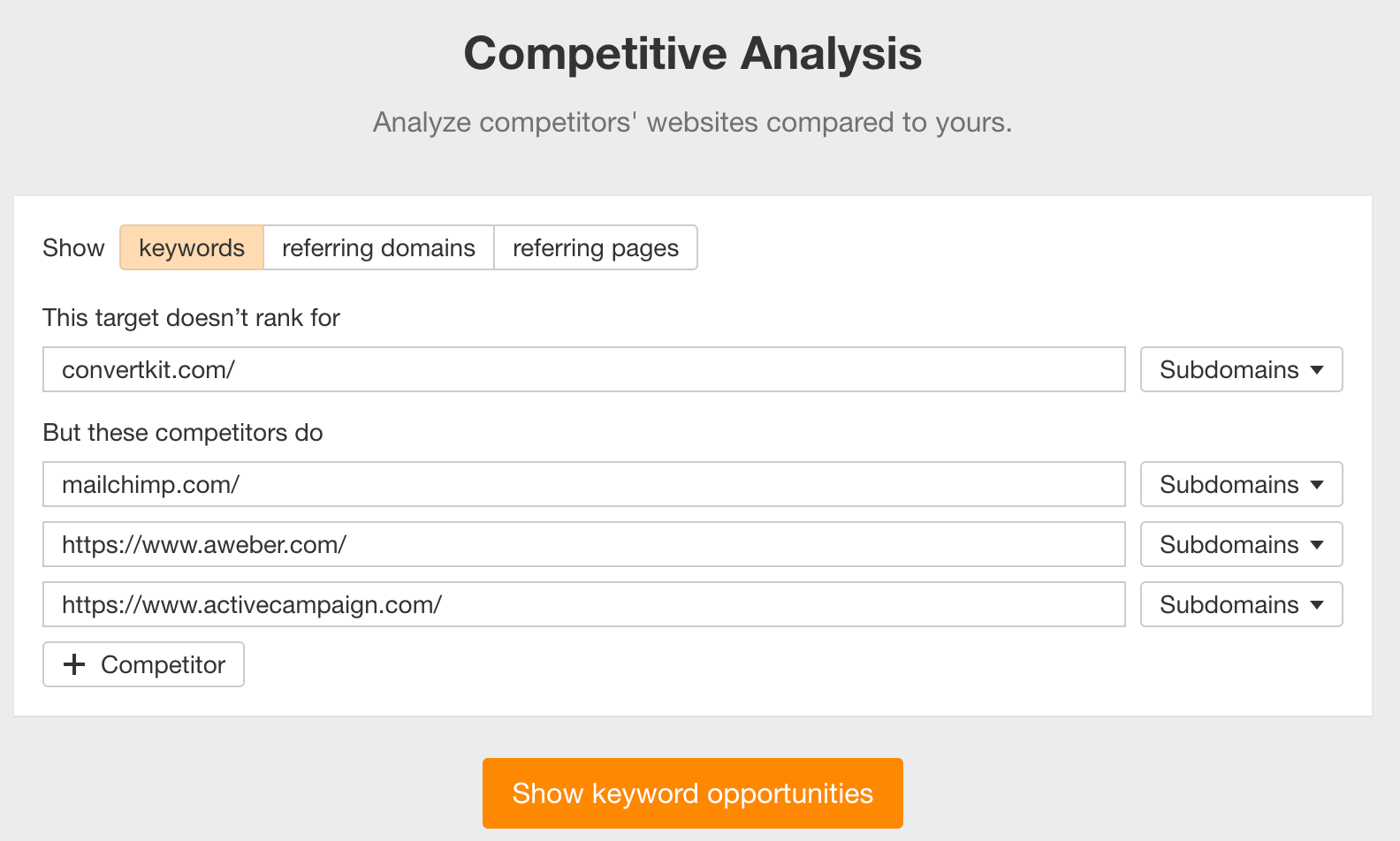

You’ll see all the keywords that at least one of these competitors ranks for, but you don’t.


You can also narrow the list down to keywords that all competitors rank for. Click on the Competitors’ positions filter and choose All 3 competitors:


- Go to Ahrefs’ Site Explorer
- Enter your competitor’s domain
- Go to the Paid keywords report
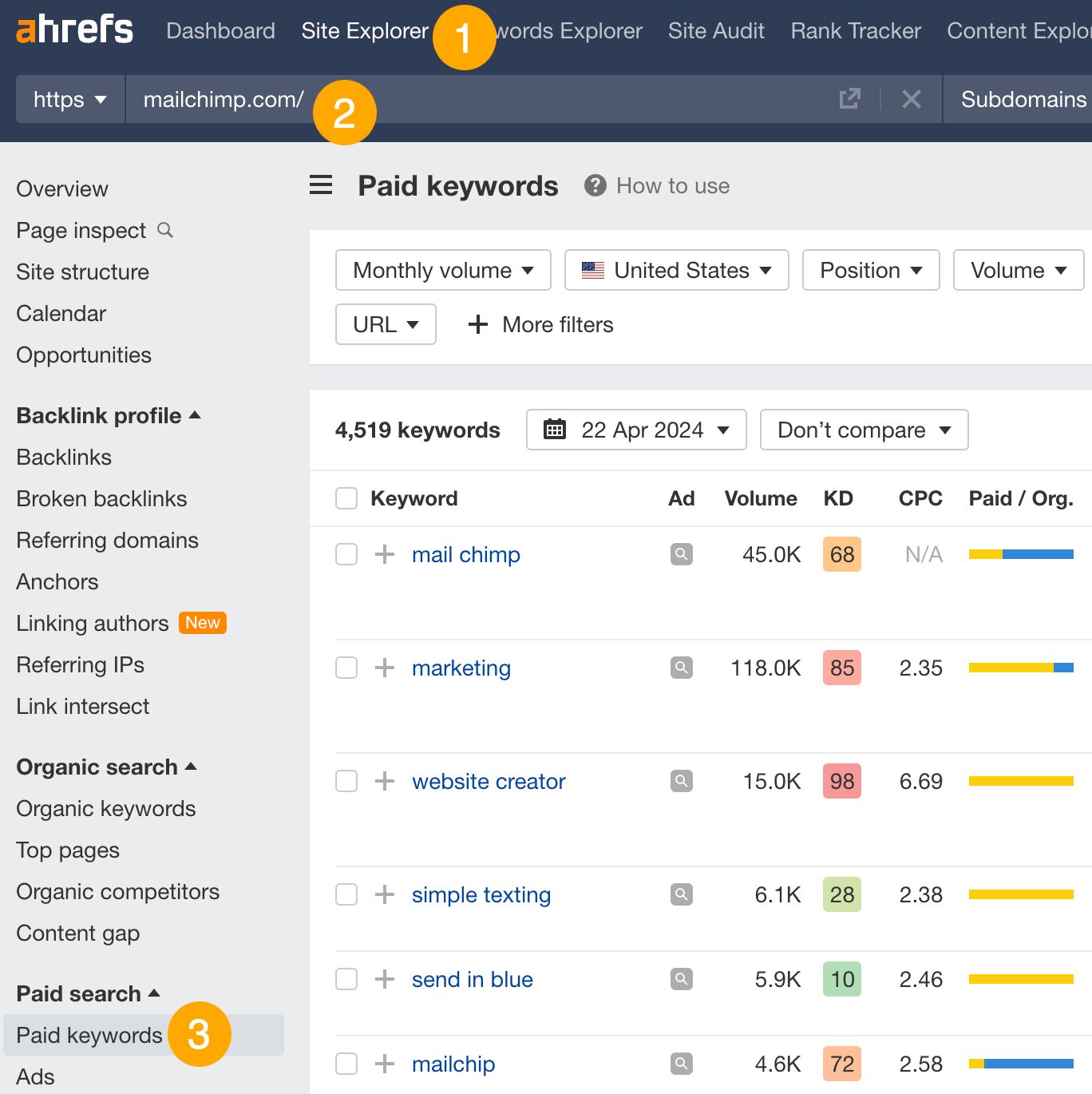

This report shows you the keywords your competitors are targeting via Google Ads.
Since your competitor is paying for traffic from these keywords, it may indicate that they’re profitable for them—and could be for you, too.
You know what keywords your competitors are ranking for or bidding on. But what do you do with them? There are basically three options.
1. Create pages to target these keywords
You can only rank for keywords if you have content about them. So, the most straightforward thing you can do for competitors’ keywords you want to rank for is to create pages to target them.
However, before you do this, it’s worth clustering your competitor’s keywords by Parent Topic. This will group keywords that mean the same or similar things so you can target them all with one page.
Here’s how to do that:
- Export your competitor’s keywords, either from the Organic Keywords or Content Gap report
- Paste them into Keywords Explorer
- Click the “Clusters by Parent Topic” tab


For example, MailChimp ranks for keywords like “what is digital marketing” and “digital marketing definition.” These and many others get clustered under the Parent Topic of “digital marketing” because people searching for them are all looking for the same thing: a definition of digital marketing. You only need to create one page to potentially rank for all these keywords.
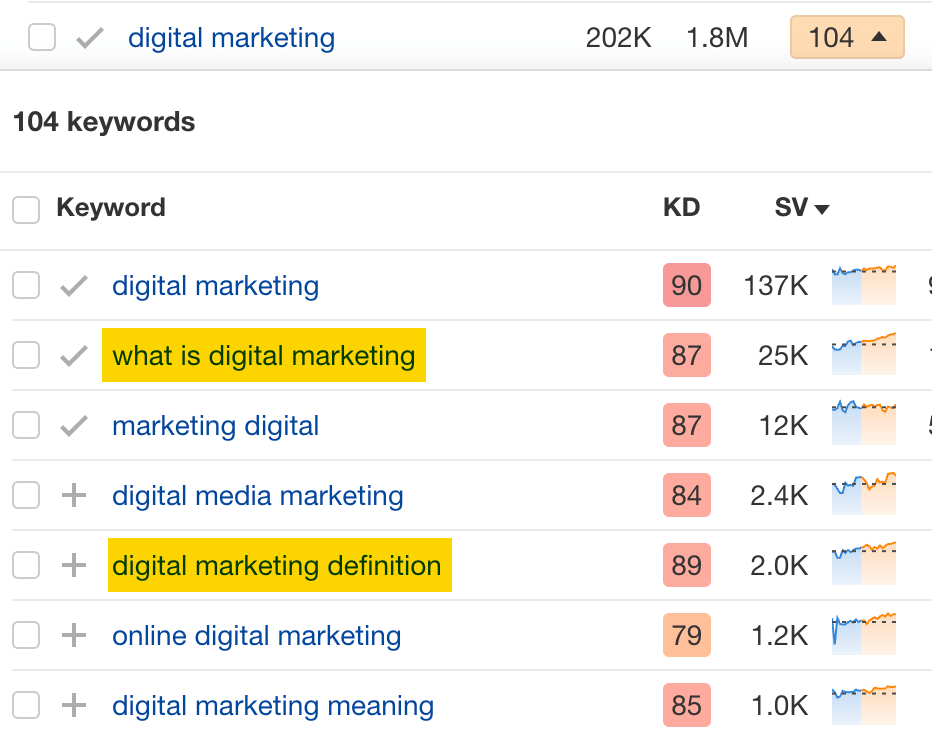

2. Optimize existing content by filling subtopics
You don’t always need to create new content to rank for competitors’ keywords. Sometimes, you can optimize the content you already have to rank for them.
How do you know which keywords you can do this for? Try this:
- Export your competitor’s keywords
- Paste them into Keywords Explorer
- Click the “Clusters by Parent Topic” tab
- Look for Parent Topics you already have content about
For example, if we analyze our competitor, we can see that seven keywords they rank for fall under the Parent Topic of “press release template.”


If we search our site, we see that we already have a page about this topic.


If we click the caret and check the keywords in the cluster, we see keywords like “press release example” and “press release format.”
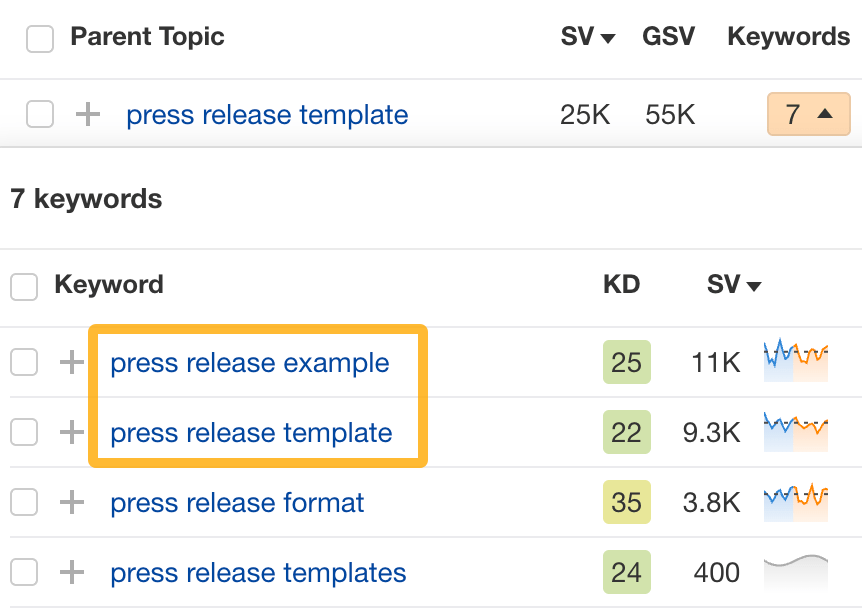

To rank for the keywords in the cluster, we can probably optimize the page we already have by adding sections about the subtopics of “press release examples” and “press release format.”
3. Target these keywords with Google Ads
Paid keywords are the simplest—look through the report and see if there are any relevant keywords you might want to target, too.
For example, Mailchimp is bidding for the keyword “how to create a newsletter.”


If you’re ConvertKit, you may also want to target this keyword since it’s relevant.
If you decide to target the same keyword via Google Ads, you can hover over the magnifying glass to see the ads your competitor is using.
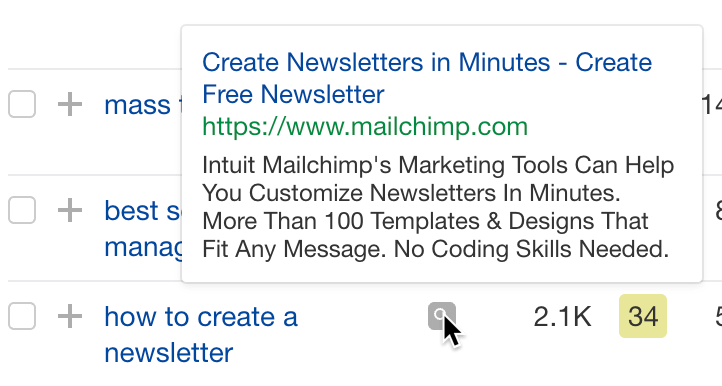

You can also see the landing page your competitor directs ad traffic to under the URL column.


Learn more
Check out more tutorials on how to do competitor keyword analysis:
SEO
Google Confirms Links Are Not That Important

Google’s Gary Illyes confirmed at a recent search marketing conference that Google needs very few links, adding to the growing body of evidence that publishers need to focus on other factors. Gary tweeted confirmation that he indeed say those words.
Background Of Links For Ranking
Links were discovered in the late 1990’s to be a good signal for search engines to use for validating how authoritative a website is and then Google discovered soon after that anchor text could be used to provide semantic signals about what a webpage was about.
One of the most important research papers was Authoritative Sources in a Hyperlinked Environment by Jon M. Kleinberg, published around 1998 (link to research paper at the end of the article). The main discovery of this research paper is that there is too many web pages and there was no objective way to filter search results for quality in order to rank web pages for a subjective idea of relevance.
The author of the research paper discovered that links could be used as an objective filter for authoritativeness.
Kleinberg wrote:
“To provide effective search methods under these conditions, one needs a way to filter, from among a huge collection of relevant pages, a small set of the most “authoritative” or ‘definitive’ ones.”
This is the most influential research paper on links because it kick-started more research on ways to use links beyond as an authority metric but as a subjective metric for relevance.
Objective is something factual. Subjective is something that’s closer to an opinion. The founders of Google discovered how to use the subjective opinions of the Internet as a relevance metric for what to rank in the search results.
What Larry Page and Sergey Brin discovered and shared in their research paper (The Anatomy of a Large-Scale Hypertextual Web Search Engine – link at end of this article) was that it was possible to harness the power of anchor text to determine the subjective opinion of relevance from actual humans. It was essentially crowdsourcing the opinions of millions of website expressed through the link structure between each webpage.
What Did Gary Illyes Say About Links In 2024?
At a recent search conference in Bulgaria, Google’s Gary Illyes made a comment about how Google doesn’t really need that many links and how Google has made links less important.
Patrick Stox tweeted about what he heard at the search conference:
” ‘We need very few links to rank pages… Over the years we’ve made links less important.’ @methode #serpconf2024″
Google’s Gary Illyes tweeted a confirmation of that statement:
“I shouldn’t have said that… I definitely shouldn’t have said that”
Why Links Matter Less
The initial state of anchor text when Google first used links for ranking purposes was absolutely non-spammy, which is why it was so useful. Hyperlinks were primarily used as a way to send traffic from one website to another website.
But by 2004 or 2005 Google was using statistical analysis to detect manipulated links, then around 2004 “powered-by” links in website footers stopped passing anchor text value, and by 2006 links close to the words “advertising” stopped passing link value, links from directories stopped passing ranking value and by 2012 Google deployed a massive link algorithm called Penguin that destroyed the rankings of likely millions of websites, many of which were using guest posting.
The link signal eventually became so bad that Google decided in 2019 to selectively use nofollow links for ranking purposes. Google’s Gary Illyes confirmed that the change to nofollow was made because of the link signal.
Google Explicitly Confirms That Links Matter Less
In 2023 Google’s Gary Illyes shared at a PubCon Austin that links were not even in the top 3 of ranking factors. Then in March 2024, coinciding with the March 2024 Core Algorithm Update, Google updated their spam policies documentation to downplay the importance of links for ranking purposes.
The documentation previously said:
“Google uses links as an important factor in determining the relevancy of web pages.”
The update to the documentation that mentioned links was updated to remove the word important.
Links are not just listed as just another factor:
“Google uses links as a factor in determining the relevancy of web pages.”
At the beginning of April Google’s John Mueller advised that there are more useful SEO activities to engage on than links.
Mueller explained:
“There are more important things for websites nowadays, and over-focusing on links will often result in you wasting your time doing things that don’t make your website better overall”
Finally, Gary Illyes explicitly said that Google needs very few links to rank webpages and confirmed it.
I shouldn’t have said that… I definitely shouldn’t have said that
— Gary 鯨理/경리 Illyes (so official, trust me) (@methode) April 19, 2024
Why Google Doesn’t Need Links
The reason why Google doesn’t need many links is likely because of the extent of AI and natural language undertanding that Google uses in their algorithms. Google must be highly confident in its algorithm to be able to explicitly say that they don’t need it.
Way back when Google implemented the nofollow into the algorithm there were many link builders who sold comment spam links who continued to lie that comment spam still worked. As someone who started link building at the very beginning of modern SEO (I was the moderator of the link building forum at the #1 SEO forum of that time), I can say with confidence that links have stopped playing much of a role in rankings beginning several years ago, which is why I stopped about five or six years ago.
Read the research papers
Authoritative Sources in a Hyperlinked Environment – Jon M. Kleinberg (PDF)
The Anatomy of a Large-Scale Hypertextual Web Search Engine
Featured Image by Shutterstock/RYO Alexandre
-

 PPC5 days ago
PPC5 days ago19 Best SEO Tools in 2024 (For Every Use Case)
-

 MARKETING7 days ago
MARKETING7 days agoStreamlining Processes for Increased Efficiency and Results
-
SEARCHENGINES6 days ago
Daily Search Forum Recap: April 17, 2024
-

 PPC7 days ago
PPC7 days ago97 Marvelous May Content Ideas for Blog Posts, Videos, & More
-

 SEO6 days ago
SEO6 days agoAn In-Depth Guide And Best Practices For Mobile SEO
-

 MARKETING6 days ago
MARKETING6 days agoEcommerce evolution: Blurring the lines between B2B and B2C
-
SEARCHENGINES5 days ago
Daily Search Forum Recap: April 18, 2024
-
SEARCHENGINES4 days ago
Daily Search Forum Recap: April 19, 2024




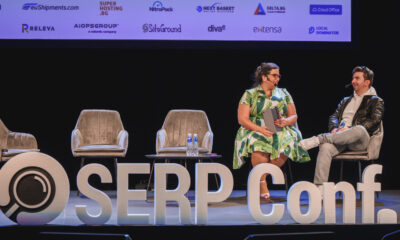





You must be logged in to post a comment Login